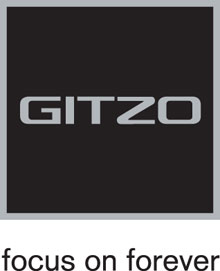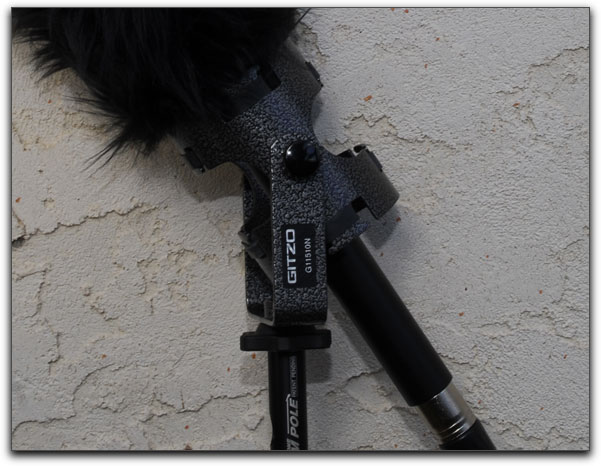
January 10, 2011
Gitzo G11510M Microphone Shockmount
http://www.gitzo.com
$225.00-boompole - $70.00-shockmount
Review by Steve Douglas
For anyone shooting on a set, whether indoors or out, achieving the best audio you can is massively important. It is the audio quality of their projects that far too many beginners and hobbyists fail to recognize as being a paramount priority.
Unfortunately, too many shooters rely on their camcorder's built in microphones to capture the audio they need only to hear less then stellar results in post production.
There are several alternatives to the cam's own microphone. There are lavaliere mics which have several valuable advantages for the videographer, and there are quality XLR shotgun and hand held microphones which also serve a variety of useful purposes in many situations. But what about those times when you don't want a microphone to show up in a scene? That's when we rely upon an external microphone attached to a boom pole. This pole is kept out of the screen and the attached microphone is aimed at the performer or subject of the shoot and kept out of the camera's view.
Boom poles can be expensive and depending upon the materials used, can be a test of your physical fitness when holding a heavy boom pole with microphone and shock mount attached when fully extended. Of all the materials used in different boom poles, the carbon fiber or aluminum boom pole is a more professional selection. Carbon fiber is more lightweight and keeps strain off of the boom operator, but it is more expensive than aluminum. The carbon fiber or aluminum boom pole, being telescopic, allows you to adjust the length to suit the scene that you are shooting.

Gitzo's Carbon Fiber GB1540 Boom pole fits my needs and alleviated my aching shoulders just fine. Not only does it have a great looking finish but the carbon fiber microphone boom pole sets the standard for me in terms of its lightweight, hardly know I'm holding it, feel. Weighing in at less than 1lb, but with a capacity weight of 4.5 lbs, its rigidity, even when fully extended to its approximately 9 foot maximum length, enabled me to keep the microphone a consistent distance away from the performer while keeping clear of the camera's view.
The Gitzo Boom Pole telescopes to its full length via 4 sections which are easily locked down with a small turn of the wrist. Once locked, they stayed locked without any undue loosening of any of the sections. As with any locking mechanism, be careful not to attempt to tighten any of the sections overmuch. They simply don't need a heavy hand and you may risk breaking the tightening mechanism as you do when over tightening any locking device.
Some boompoles are "cabled", others are not. The Gitzo GB 1540 is not. An opening towards the tip of the Gitzo allows for snaking a mic cord through to the bottom of the poles grip. A small hole at the grips bottom would probably need to be enlarged for anyone wanting to snake an XLR cable through. An alternative for permanent cable integration would be to run a cable without the XLR mounts from the end of the pole through the handles bottom hole and then attach the XLR components. You'd have to remove and re-solder the cable ends to make it fit, but it is possible to do. A thinner cable would be best if you choose to do this. To my thinking, this might produce its own problem when collapsing the pole to its minimum length of 34" as kinking of the cable might occur, so you would need to collapse the pole very carefully.
A cabled boompole has a coiled microphone cable that runs internally through the pole. The end of the cable sticks out of the top of the pole and allows you to plug-in your microphone. An XLR output jack is installed at the bottom of the pole. This enables you to attach a microphone cable to the pole. The cabled boompole can then be plugged into a videocamera, a recording device, a mixer, or a wireless transmitter.
The nice thing about a cabled pole is that set-up time is faster. In "run and gun" production situations (news reporting, reality television, etc.) a cabled boompole may be a necessity. However, you should be aware that cabled boompoles have added weight and collapsing the pole also needs to be done carefully to avoid kinking the internal cable. Another plus for using a non-cabled pole like the Gitzo GB 1540 is that the audio signal doesn't have to pass through two separate audio cables to get to its destination. In this situation, the loss of audio quality is minor, but still, it doesn't hurt to avoid it. You also have your choice of what kind of microphone cable to use as opposed to a pre-fitted cable that might not match your needs.
For many of the more costly boom poles the opening for cable run through is not at the bottom of the handle. Running the cable through the bottom prevents the user from resting the pole leaning against a wall or simply holding it as you would a monopod when not in use. Doing so, may damage the cable itself. If I were to change one thing in regards to the GB 1540 it would be to have the pole use a 'side exit' near the pole's handle so that the XLR cable could not be damaged by resting the base of the pole on the ground between takes. For my uses, I simply used a couple of pieces of clean gaffers tape once the Gitzo was extended and taped the cables to the outside of the pole.

The Gitzo G11510N Microphone holder/shock mount made for a nice combination and fit with the boompole. Made of aluminum, and not breakable plastic, it fit the 3/8" mounting screw of the GB1540 boompole while being able to accommodate any microphone with a diameter from 0.75-1.5". The shockmount is considerably lighter in weight than it appears to be in the picture. Using my Azden shotgun microphone, I found that the mic's 21mm diameter was not quite wide enough to be held tightly by the shock bands. It wasn't as if it were sliding out or couldn't be held in place by the shock mount, its just that I would have preferred a tighter fit. Repositioning the angle of the head was easy. The shockmount comes with standard rubber membrane suspension bands though I would suggest purchasing spares should one break like any rubber band might do after time.
I'm sure that there are still some who attach their microphones to broom handles with duct tape and do their best to keep that heavy pole out of the camcorder's frame. However, for those who are seeking a low cost and absolutely featherweight boom pole, I believe you will be most happy with Gitzo's GB1540 and G11510N Shockmount. The cost is reasonable and the alleviation of all that weight during long and repeated shoots is most welcome.

Steve Douglas is a certified Apple Pro for Final Cut Pro 7 and underwater videographer. A winner of the 1999 Pacific Coast Underwater Film Competition, 2003 IVIE competition, 2004 Los Angeles Underwater Photographic competition, and the prestigious 2005 International Beneath the Sea Film Competition, where he also won the Stan Waterman Award for Excellence in Underwater Videography and 'Diver of the Year', Steve was a safety diver on the feature film "The Deep Blue Sea", contributed footage to the Seaworld Park's Atlantis production, and productions for National Geographic and the History channels. Steve was a feature writer for Asian Diver Magazine and is one of the founding organizers of the San Diego UnderSea Film Exhibition. He is available for both private and group seminars for Final Cut Pro and leads underwater filming expeditions and African safaris with upcoming excursions to the Cocos Islands, Costa Rica, Lembeh Straits, Indonesia, and Wakatobi. Feel free to contact him if you are interested in joining Steve on any of these exciting trips. www.worldfilmsandtravel.com
[Top]
copyright © Steve Douglas 2011
are either registered trademarks or trademarks of Apple. Other company and product names may be trademarks of their respective owners.
All screen captures, images, and textual references are the property and trademark of their creators/owners/publishers.